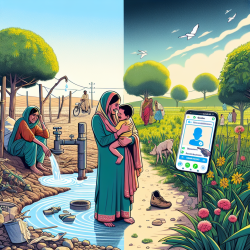Introduction
Water insecurity is a pressing issue that impacts various aspects of life, particularly in low-and-middle-income countries. A recent qualitative study conducted in South-Punjab, Pakistan, sheds light on the multifaceted consequences of water insecurity, particularly on maternal and child health. This blog explores the findings of the study and discusses how speech-language pathologists and other practitioners can leverage this information to improve outcomes for children.
Key Findings from the Study
The study, titled "A Qualitative Exploration in Causes of Water Insecurity Experiences, and Gender and Nutritional Consequences in South-Punjab, Pakistan," highlights several critical points:
- Rural populations in the Rajanpur district rely on unsafe water sources, leading to significant health challenges.
- Water fetching increases the burden on mothers, contributing to stress and health issues.
- Water insecurity exacerbates gender inequities and impacts maternal and child nutrition.
- Improving water access is essential for enhancing public health nutrition and reducing maternal stress.
Implications for Practitioners
As practitioners, understanding the broader socio-environmental factors affecting children's health is crucial. Here are some ways to integrate these findings into practice:
- Advocate for Comprehensive Interventions: Encourage policies that address water insecurity as part of a holistic approach to child health and development.
- Focus on Family-Centered Care: Consider the family's access to resources, including water, when planning interventions for children.
- Promote Awareness and Education: Educate families about the importance of safe water and its impact on health and development.
- Collaborate with Other Sectors: Work with public health, nutrition, and policy experts to address the root causes of water insecurity.
Encouraging Further Research
The study underscores the need for further research into the complex interplay between water insecurity and health outcomes. Practitioners can play a role by:
- Participating in interdisciplinary research initiatives.
- Contributing to data collection and analysis on the impact of environmental factors on child development.
- Sharing insights from practice to inform research priorities.
Conclusion
Water insecurity is a significant barrier to optimal health and development for children in affected regions. By understanding and addressing these challenges, practitioners can contribute to better health outcomes and support the well-being of children and families. To delve deeper into the research, please read the original paper: A Qualitative Exploration in Causes of Water Insecurity Experiences, and Gender and Nutritional Consequences in South-Punjab, Pakistan.










